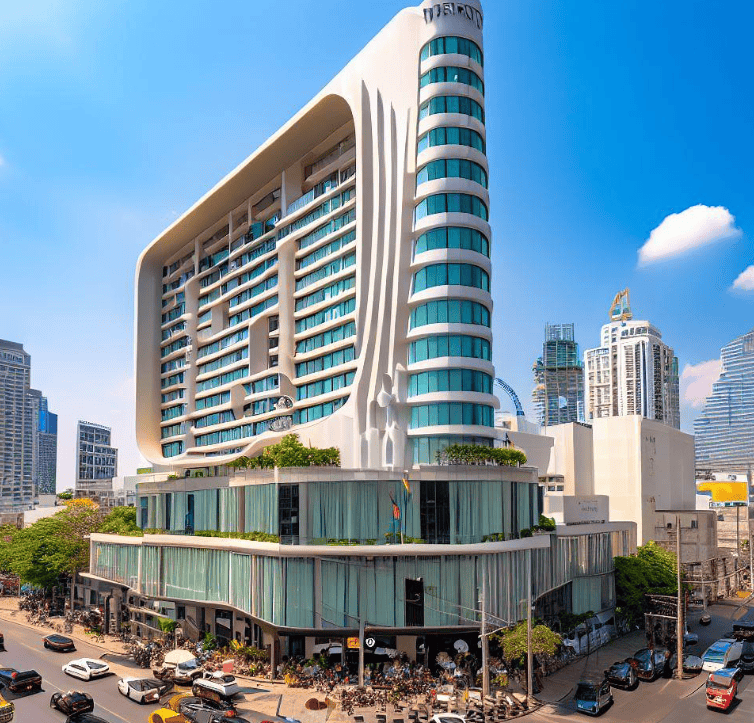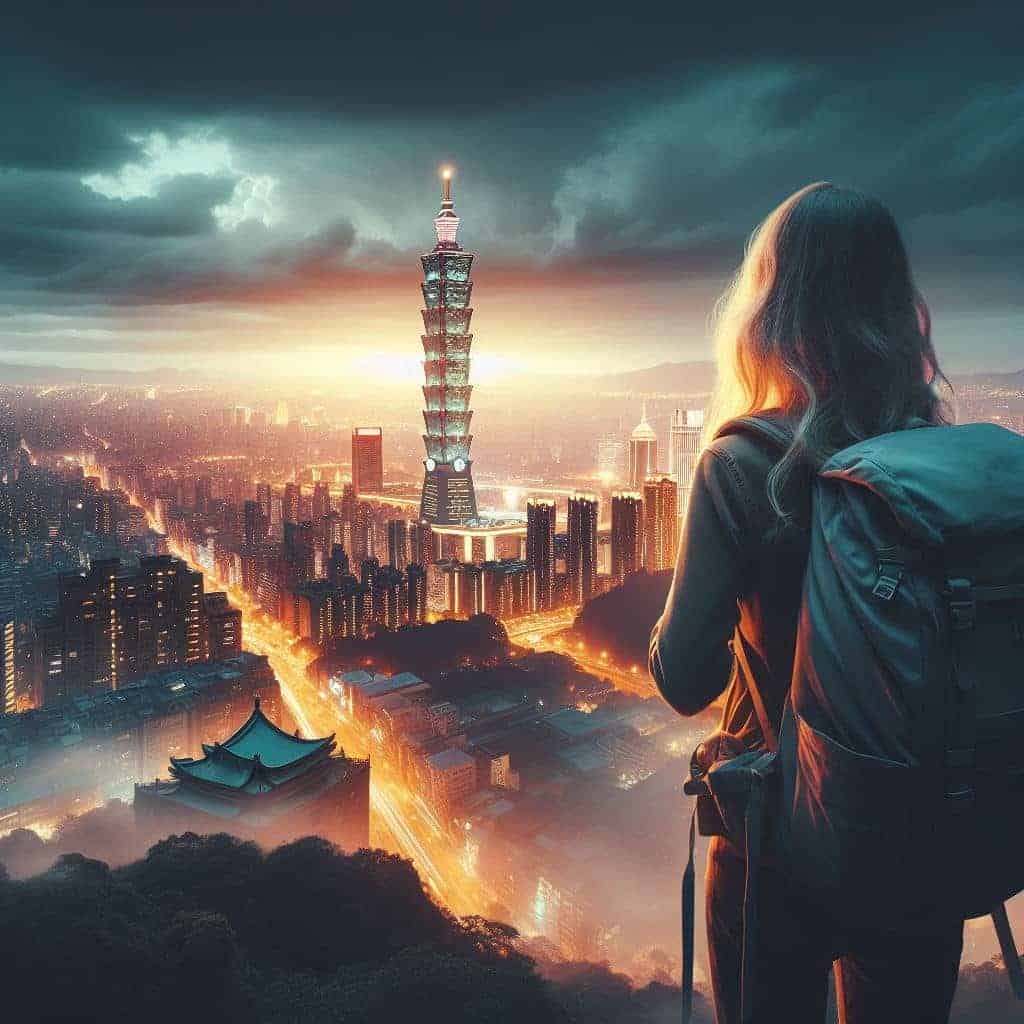Welcome to a journey through the breathtaking sights and experiences that the Philippines has to offer. As a seasoned tourism guide with decades of expertise in this tropical paradise, I’m excited to be your trusted resource for exploring the 10 best Philippines Sightseeing Places. With a wealth of knowledge acquired through years of exploration and interaction with travelers from around the world, I’m committed to providing you with in-depth insights and insider tips to make your visit to these remarkable destinations unforgettable.
The Philippines, an archipelago of over 7,000 islands, is a nation characterized by its rich cultural tapestry and natural wonders. Throughout the years, I’ve had the privilege of witnessing the country’s diverse landscapes, vibrant traditions, and captivating history. This blog post not only draws upon my personal experiences but also incorporates credible sources to ensure that the information is accurate, unbiased, and up-to-date.
As we embark on this virtual journey, I’ll be your guide, offering you a taste of the Philippines’ hidden gems and iconic landmarks. Whether you’re an adventure seeker, a history enthusiast, or a nature lover, this list has something for everyone. Join me as we explore the remarkable places that make the Philippines a must-visit destination for travelers seeking unforgettable sightseeing experiences.
So, fasten your seatbelts, or should I say, “Put on your hiking boots and get ready to dive in,” as we dive into the 10 Best Sightseeing Places in the Philippines.
10 Best Philippines Sightseeing Places
1. Banaue Rice Terraces
The Banaue Rice Terraces, often referred to as the “Eighth Wonder of the World,” are a testament to the incredible ingenuity and determination of the Ifugao people. As we delve into our list of the top sightseeing places in the Philippines, this is a must-visit for anyone seeking a blend of breathtaking natural beauty and cultural significance.
The Marvel of Banaue Rice Terraces
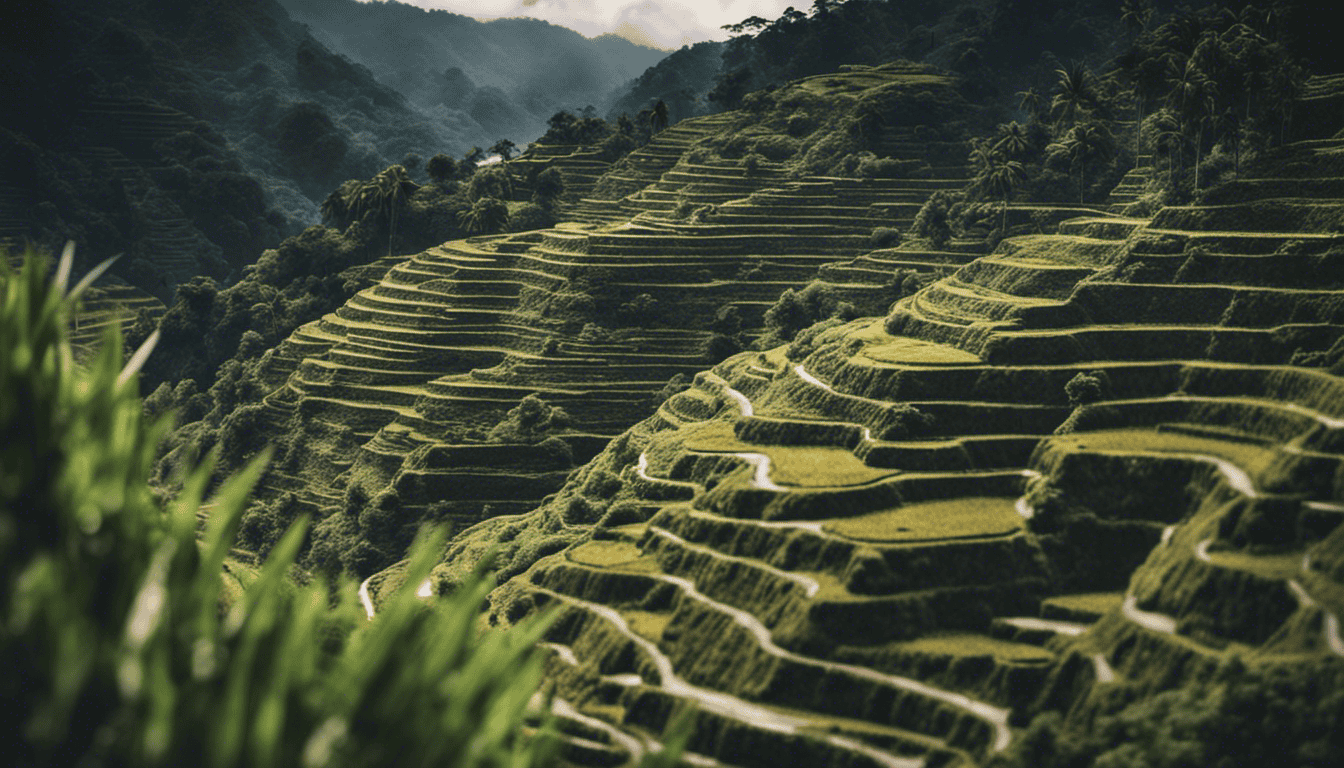
Carved into the slopes of the Cordillera mountain range in northern Luzon, these rice terraces showcase the Ifugao’s age-old agricultural practices, ingeniously designed to make the most of the region’s challenging terrain. It’s a living testament to their engineering prowess, and the entire site has been declared a UNESCO World Heritage Site since 1995.
These stunning terraces are often dubbed the “stairway to the heavens” due to their staggering height and intricate design. What’s truly remarkable is that these terraces have been continuously cultivated for over 2,000 years, providing the Ifugao people with sustenance and a deep cultural connection to the land.
Experiencing Banaue
When you visit Banaue, you have the opportunity to do more than just admire the terraces from afar. You can take hikes and guided tours that bring you up close to these marvels, allowing you to gain a deeper appreciation for the intricate stonework and rice cultivation methods. Engaging with the local communities is an integral part of the experience, as it offers insights into the Ifugao way of life.
Traveler’s Tip:
The best time to visit is during the planting or harvest season (April to May and October to November). During these times, the terraces are a mesmerizing green or golden hue, providing the most striking views for your photographs.
As we move forward in our exploration of the Philippines’ finest sightseeing destinations, remember that Banaue Rice Terraces is just the beginning of an incredible journey through this diverse and captivating archipelago.
2. Chocolate Hills, Bohol
In the heart of the Visayas region lies one of the Philippines’ most peculiar and captivating natural wonders – the Chocolate Hills. As your trusted guide, I’ll take you through the enchanting world of these unique geological formations and share how to make the most of your visit to this incredible site.
The Geological Marvel of the Chocolate Hills
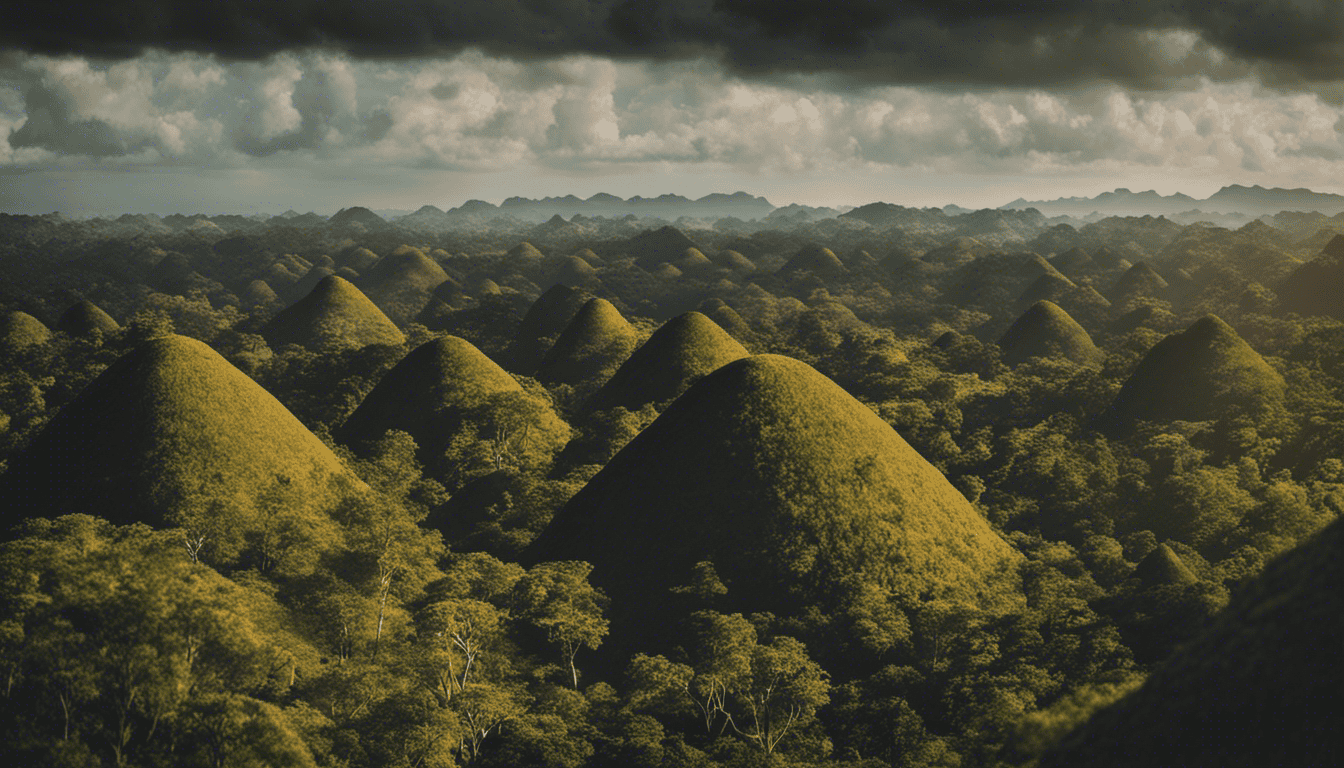
The Chocolate Hills, spread across the province of Bohol, consist of approximately 1,268 cone-shaped hills that seem to stretch endlessly across the landscape. They get their name because during the dry season, the grass covering the hills turns a rich, chocolatey brown, creating a mesmerizing and picturesque sight.
Geologists believe that these hills were formed from the uplift of coral deposits and the action of rainwater and erosion over thousands of years. Each hill is covered in green grass, making them resemble giant Hershey’s Kisses.
Best Viewpoints and Photography Tips
When visiting the Chocolate Hills, there are a few key viewpoints you should make sure to include in your itinerary:
- Sagbayan Peak: Offering panoramic views and a butterfly sanctuary, Sagbayan Peak is a great starting point.
- Carmen Viewing Deck: Located in Carmen, this is the most popular spot for viewing the Chocolate Hills. An observation deck provides an excellent vantage point for taking stunning photographs.
- Chocolate Hills Complex: This complex in Carmen also includes an ATV adventure that allows you to explore the hills more closely.
Exploring Beyond the Hills
While the Chocolate Hills themselves are a breathtaking sight, Bohol has much more to offer. Don’t miss a visit to the Tarsier Sanctuary, where you can observe the world’s smallest primates, the Philippine Tarsier, in their natural habitat. Bohol is also known for its beautiful beaches, including Alona Beach, which is perfect for a bit of relaxation.
Traveler’s Tip:
Visit the Chocolate Hills early in the morning or late in the afternoon to avoid the midday heat and get the best lighting for your photographs.
As we continue our journey through the Philippines, the Chocolate Hills are just the tip of the iceberg. There’s so much more to explore, and our next stop will take us to a natural wonder of a different kind – the Mayon Volcano in Albay.
3. Mayon Volcano, Albay
Known as the “Perfect Cone” and considered one of the most picturesque volcanoes in the world, Mayon Volcano in Albay is a natural wonder you won’t want to miss. Join me as we explore this iconic landmark and uncover the fascinating stories surrounding its beauty and power.
The Beauty of Mayon’s Symmetry
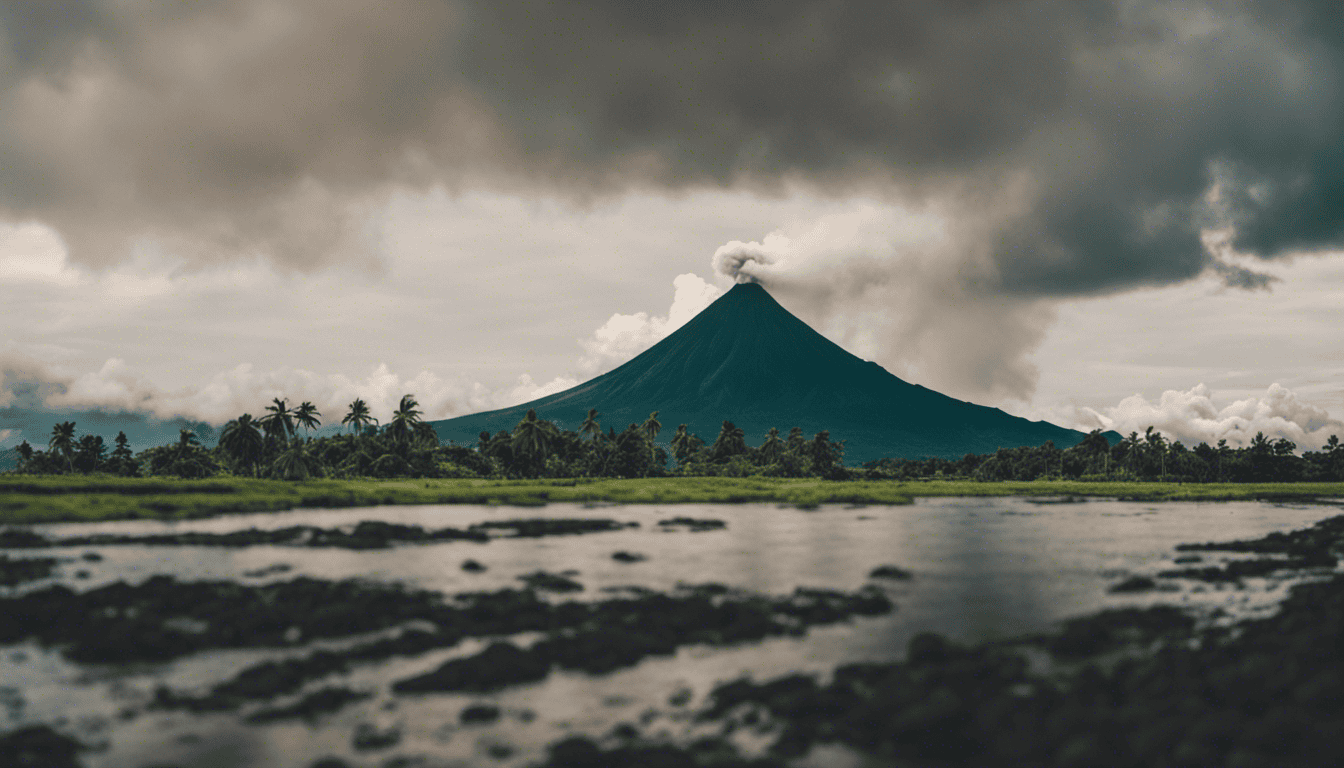
Mayon Volcano is celebrated for its near-perfect symmetrical cone shape, making it a popular subject for postcards, photographs, and artwork. Standing at 2,463 meters (8,081 feet) above sea level, it’s an active stratovolcano located in the province of Albay, on the island of Luzon. This incredible natural wonder is a part of the Pacific Ring of Fire, known for its seismic and volcanic activity.
The Legends and Folklore
Beyond its striking appearance, Mayon Volcano is steeped in local legends and folklore. The most famous of these stories is the tragic tale of Daragang Magayon, which translates to “Beautiful Lady.” It’s believed that the volcano’s beauty symbolizes the love story between Daragang Magayon and the warrior Panganoron. This narrative adds a layer of cultural richness to the already captivating landscape.
The Best Viewing Spots
To truly appreciate Mayon’s grandeur, you’ll want to visit some of the best viewing spots:
- Cagsawa Ruins: This historical site in Daraga offers a perfect view of Mayon Volcano. The Cagsawa Ruins are the remnants of a church buried by volcanic debris during the eruption in 1814.
- Lignon Hill: Located in Legazpi City, Lignon Hill provides an elevated perspective of the volcano and the city.
- Mayon Rest House: You can also head to the Mayon Rest House for a more intimate experience and scenic views. It’s situated on the slopes of the volcano and offers the chance to take in the beauty while enjoying local cuisine.
Experiencing Mayon Volcano
While visiting Mayon Volcano, you can do more than just admire its beauty from a distance. Adventurous travelers have the opportunity to hike to the summit, although this is a challenging endeavor that should only be undertaken with an experienced guide. The hike provides a unique perspective of the volcano and the surrounding landscapes.
Traveler’s Tip:
Mayon’s activity is closely monitored, and there may be periods when access to certain areas is restricted due to volcanic activity. Be sure to check the latest information before planning your visit.
Our journey through the Philippines’ most remarkable sights continues with our next stop being the stunning Taal Volcano and the mystical Taal Lake. Stay with us as we explore more of this enchanting archipelago.
4. Taal Volcano and Taal Lake
Prepare to be amazed by the wonder of Taal Volcano, an island within a lake within an island, located just a short drive from the bustling metropolis of Manila. In this section of our journey through the Philippines’ best sightseeing places, we’ll delve into the unique beauty and adventure that await you at Taal.
The Unique Geological Marvel
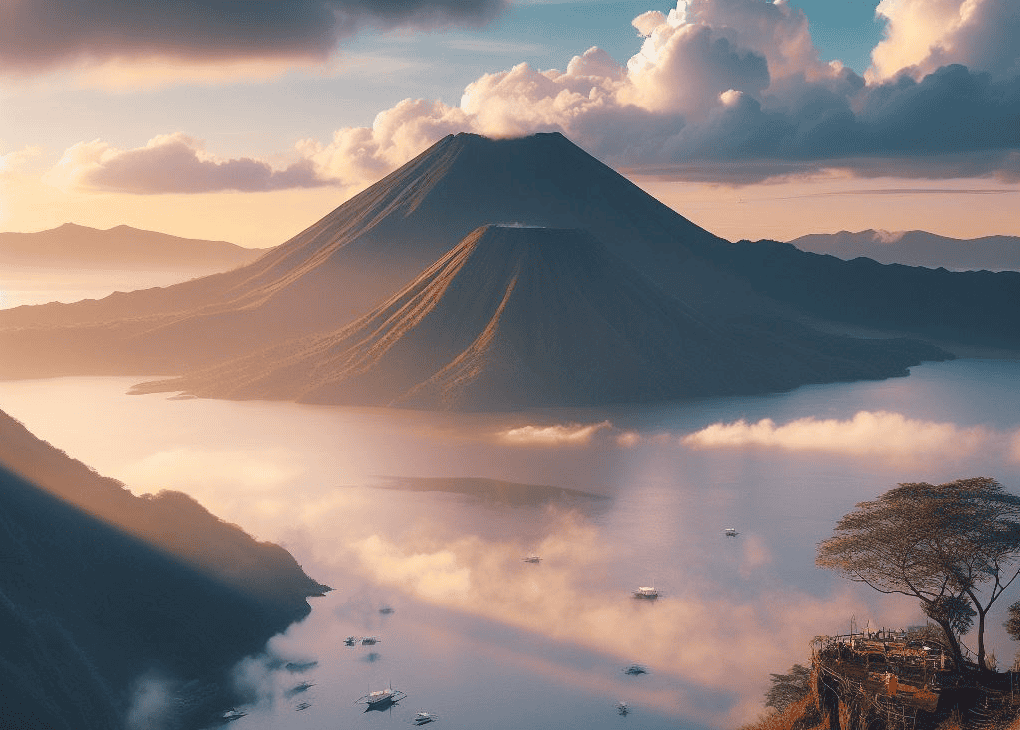
Taal Volcano is often described as the “volcano within a volcano.” It’s situated on an island within Taal Lake, which is on the island of Luzon. This geological marvel is a testament to the Philippines’ extraordinary landscapes. The main crater of Taal is itself an active volcano, surrounded by a pristine lake, offering a scene of unparalleled natural beauty.
Hiking to the Crater
For the adventurous traveler, the main attraction is the hike to the rim of Taal’s main crater. The hike offers breathtaking panoramic views of the volcanic island and the surrounding Taal Lake. It’s an exciting adventure that takes you through lush landscapes and up to the crater rim.
The trek starts with a boat ride to the island, followed by a horseback ride to the base of the volcano. From there, it’s a hike to the summit. The hike can be a bit challenging, but the views from the top make it all worthwhile. Remember to wear comfortable clothing and sturdy shoes, and stay hydrated as the sun can be intense.
Boat Tours on Taal Lake
If hiking isn’t your thing, you can still enjoy the beauty of Taal by taking a boat tour on the lake. Several operators offer guided tours that take you to different parts of the lake, including viewpoints where you can admire the volcano from the water. It’s a more relaxed way to experience the majesty of Taal.
Visitor’s Tip:
The best time to visit Taal Volcano is during the dry season (November to April) when the skies are clearer, and hiking conditions are at their best.
As we continue our exploration of the Philippines’ finest sightseeing destinations, our next stop will take us underground to the mesmerizing Puerto Princesa Underground River in Palawan. Stay with us as we uncover more of the country’s natural wonders and cultural treasures.
5. Underground River, Palawan
Welcome to a subterranean world of wonder and mystery in Palawan, home to the Puerto Princesa Underground River, a UNESCO World Heritage Site and one of the New 7 Wonders of Nature. Join me as we venture into the depths of this mesmerizing river cave system.
The Subterranean Spectacle
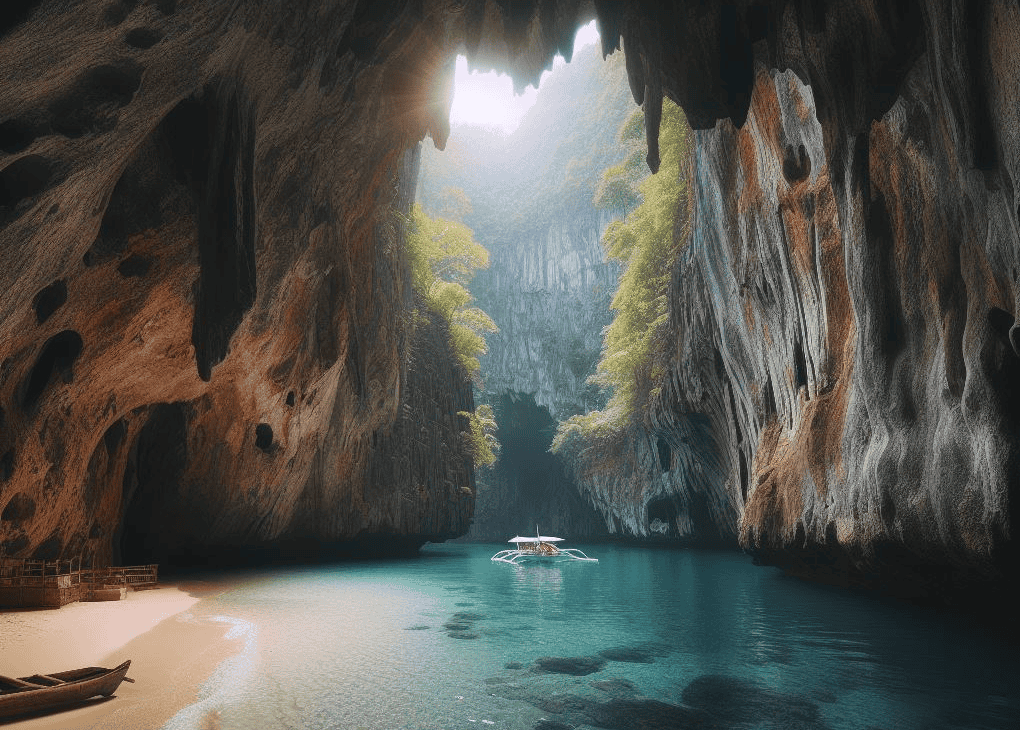
The Puerto Princesa Underground River is a natural wonder that has captured the imaginations of travelers and explorers for generations. This 8.2-kilometer (5.1-mile) river flows through a cave system, making it one of the longest navigable underground rivers in the world. As you journey through the cave, you’ll be immersed in an otherworldly experience of intricate rock formations and an eerie, almost mystical, atmosphere.
Rich in Biodiversity
This underground river is more than just a geological marvel; it’s also home to a remarkable variety of wildlife. The cave’s interior is inhabited by unique species, some of which are found nowhere else on Earth. Among the inhabitants, you may spot swiftlets, bats, and various insects. As you drift along the river, your guide will point out these fascinating creatures.
Navigating the Underground River
Exploring the underground river is an adventure in itself. You’ll board a paddleboat at Sabang Beach, and your journey into the cave will be guided by experienced locals who know the cave system like the back of their hand. As you glide through the river’s dark passages, you’ll marvel at the various formations, such as the “Cathedral,” “Pillars of Heaven,” and “The Fruit Bat Chamber.”
Permits and Eco-Friendly Practices
Due to its status as a UNESCO World Heritage Site, the number of visitors allowed into the underground river is regulated. It’s important to secure permits well in advance to ensure you can experience this natural wonder.
Additionally, practicing responsible and eco-friendly tourism is highly encouraged. Visitors are asked to follow guidelines to protect the environment and the fragile cave ecosystem. This includes restrictions on the use of flash photography and noise levels to minimize disturbances to wildlife.
Traveler’s Tip:
To secure your permits, it’s best to contact a reputable tour operator in advance, as they can assist with the necessary arrangements.
As we journey further through the Philippines, you’ll find that the country is abundant with unique and awe-inspiring destinations. Our next stop will take us beneath the waves to the Tubbataha Reefs Natural Park, where you can explore some of the most pristine coral reefs in the world. Stay with us to uncover more of the Philippines’ natural treasures.
6. Tubbataha Reefs Natural Park
Prepare to be mesmerized by the incredible underwater world of the Tubbataha Reefs Natural Park, a remote marine paradise that’s a true gem for divers and nature enthusiasts. As we venture into the depths of this UNESCO World Heritage Site, you’ll discover a world of vibrant marine life and pristine coral reefs.
A Marine Wonderland
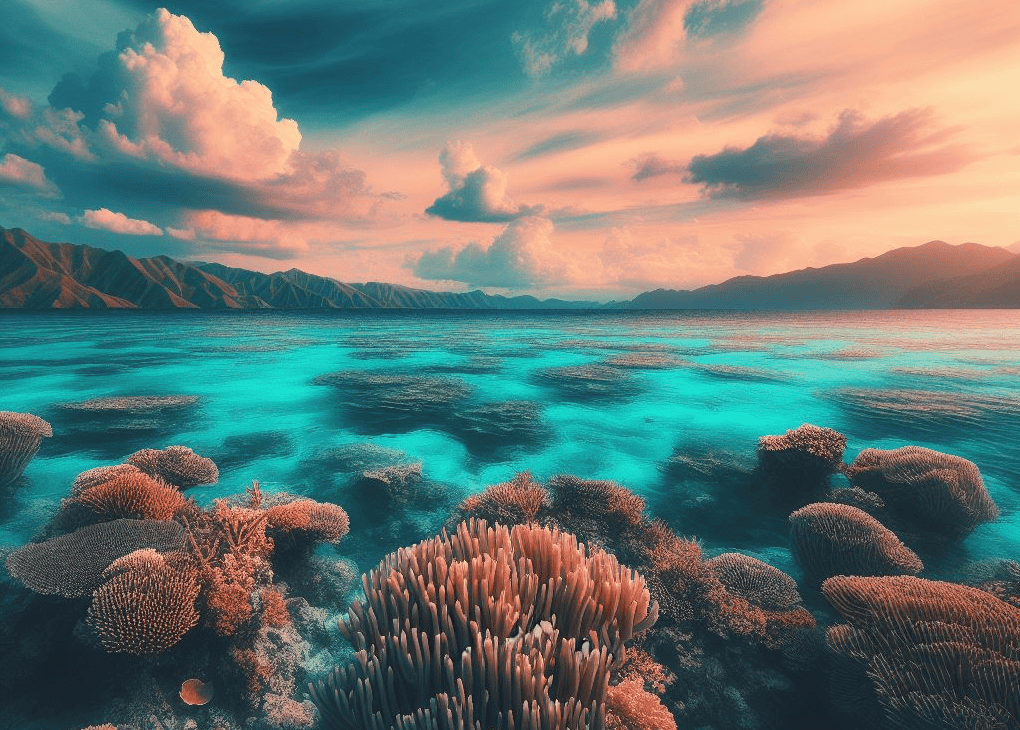
Tubbataha Reefs Natural Park is located in the Sulu Sea, in the middle of the Philippines. This protected area consists of two coral atolls, simply known as the North Atoll and the South Atoll. What sets Tubbataha apart is its extraordinary biodiversity and pristine condition, making it one of the most coveted dive destinations in the world.
Diving in Tubbataha
For divers, Tubbataha is a dream come true. The park’s crystal-clear waters are home to an astonishing variety of marine life. You’ll encounter vibrant coral gardens, schools of colorful reef fish, sharks, turtles, manta rays, and even the elusive whale shark. It’s a place where both novice and experienced divers can explore the underwater wonderland.
The best way to experience Tubbataha is through a liveaboard diving expedition. These multi-day trips offer a chance to explore different dive sites and fully immerse yourself in the underwater beauty of the park.
Conservation and Preservation
Tubbataha is not just a paradise for divers; it’s also a testament to the importance of marine conservation. The park is recognized as a vital area for the conservation of marine life, and as such, strict rules are in place to protect its fragile ecosystem.
While visiting, it’s essential to follow the rules and guidelines set by the park authorities and your dive operators to minimize the impact on the reefs. This includes practices like not touching the corals and avoiding any disturbance to the wildlife.
Traveler’s Tip:
The best time to visit Tubbataha Reefs Natural Park is during the dive season, which typically runs from March to June when the sea conditions are most favorable.
As we continue our journey through the Philippines, you’ll discover that this country is not only known for its stunning landscapes but also for its rich cultural heritage. Our next stop takes us to the captivating Pagsanjan Falls in Laguna. Join us as we explore more of the Philippines’ natural and cultural treasures.
7. Pagsanjan Falls, Laguna
Prepare to be captivated by the beauty and adventure that awaits you at Pagsanjan Falls in Laguna, a natural masterpiece that has been drawing visitors for centuries. As we explore this iconic waterfall and the thrilling journey to reach it, you’ll understand why it’s a must-visit destination in the Philippines.
The Spectacle of Pagsanjan Falls
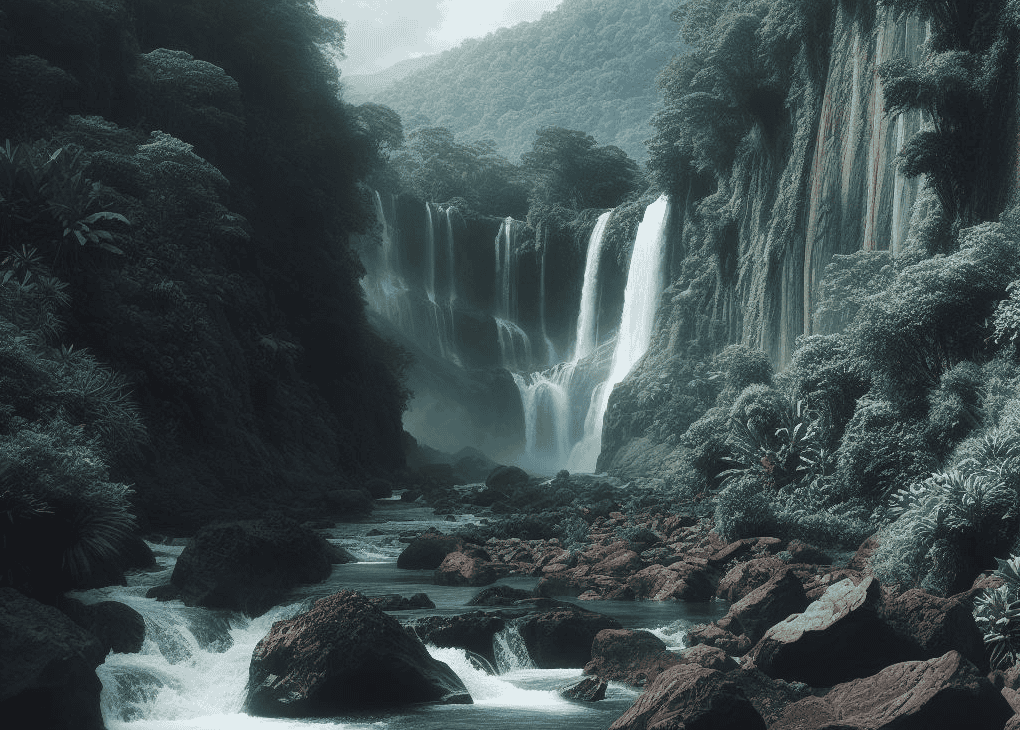
Pagsanjan Falls is a three-tiered waterfall located in the town of Pagsanjan, in the province of Laguna. This stunning cascade tumbles from the top of a high cliff, creating a breathtaking sight and the perfect backdrop for nature lovers and adventurers.
The falls are not just a sight to behold; they have also been featured in various films and literary works, adding to their cultural significance in the Philippines.
The Thrilling Boat Ride
The adventure to reach Pagsanjan Falls is as exciting as the destination itself. To get there, you’ll hop on a local canoe or banca, which is expertly maneuvered by skilled boatmen. The journey takes you through a scenic gorge along the Pagsanjan River, and it’s an exhilarating experience as you navigate the river’s twists and turns.
As you approach the falls, the boatmen use their exceptional skills to ensure you get a unique and up-close view of Pagsanjan Falls. The boat ride is an essential part of the experience, and you’ll feel the refreshing mist from the waterfall as you get closer.
Pagsanjan Beyond the Falls
Pagsanjan offers more than just the falls. The town itself is charming, with Spanish colonial architecture and a laid-back atmosphere. You can explore the historical and cultural heritage of the area, which includes the church of Our Lady of Guadalupe.
Traveler’s Tip:
Be prepared to get wet during the boat ride. It’s a good idea to bring a change of clothes and protect your camera or phone from the water.
As we journey further through the Philippines, you’ll find that this beautiful country is a tapestry of natural wonders and cultural treasures. Our next stop will take us to Vigan, Ilocos Sur, a well-preserved Spanish colonial town where you can step back in time and immerse yourself in history and heritage. Stay with us as we continue to uncover the Philippines’ hidden gems.
8. Vigan, Ilocos Sur
Step back in time and experience the enchanting charm of Vigan, a beautifully preserved Spanish colonial town nestled in Ilocos Sur. As we explore this UNESCO World Heritage City, you’ll discover a place where history comes to life, and where the cobblestone streets and ancestral houses whisper tales of the past.
The Timeless Beauty of Vigan
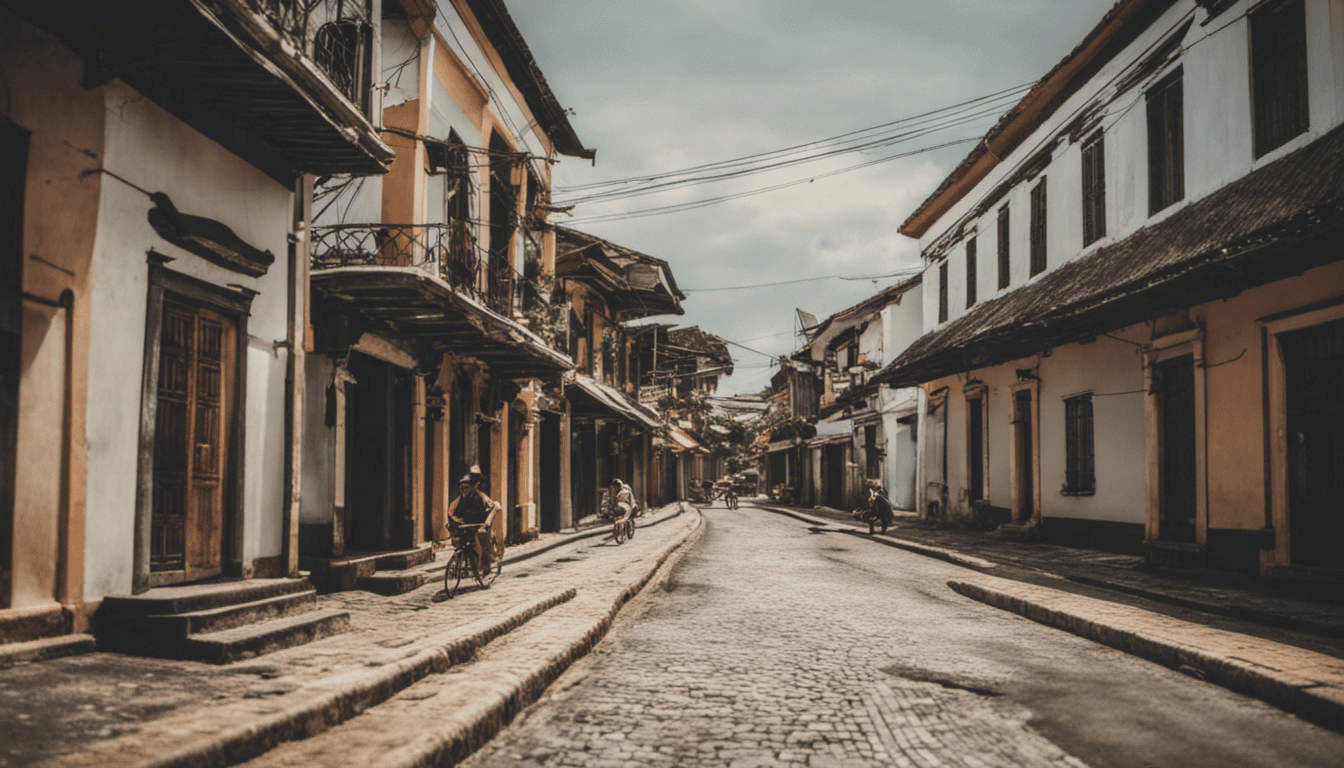
Vigan is a city frozen in time, a living museum of Spanish colonial architecture and traditions. The well-preserved town boasts cobblestone streets, colonial-era houses, and historic landmarks that transport you to a bygone era. It’s no surprise that Vigan has been recognized as a UNESCO World Heritage Site, ensuring its cultural heritage is protected for generations to come.
Calesa Rides and Cobblestone Streets
One of the best ways to explore Vigan is by taking a calesa, a traditional horse-drawn carriage. It’s a leisurely and charming way to soak in the ambiance of the town while your guide narrates stories about the historic buildings you pass by.
The cobblestone streets of Calle Crisologo, in particular, are a delight to wander. Lined with ancestral homes and antique shops, this street takes you back to the Spanish colonial period.
Historic Sites and Museums
Vigan is not just about its architecture; it’s also a place where history comes alive. Don’t miss the following historic sites:
- Crisologo Museum: This museum is a tribute to the life and work of Congressman Floro S. Crisologo. It’s located in his ancestral home and showcases his personal belongings and contributions to Ilocano history.
- Syquia Mansion: The ancestral home of former Philippine President Elpidio Quirino, this mansion now serves as a museum. It offers insights into the life and times of a prominent political figure.
- Bantay Church Bell Tower: Climb the tower for panoramic views of Vigan and the surrounding countryside.
Local Cuisine and Souvenirs
Vigan is also famous for its culinary delights. Be sure to sample local specialties such as Vigan longganisa (sausage) and empanada, a savory pastry filled with meat and vegetables.
While in Vigan, you can also shop for souvenirs, including traditional crafts, antiques, and the city’s renowned handwoven products.
Traveler’s Tip:
Visit Vigan early in the morning or late in the afternoon to experience the town when it’s less crowded, and the soft light adds to its picturesque ambiance.
As we journey through the Philippines, you’ll find that this country is a treasure trove of historical and cultural wonders. Our next destination is the highest peak in the Philippines, Mount Apo in Mindanao. Join us as we explore this natural wonder and learn about the rich biodiversity of the region.
9. Mount Apo, Mindanao
Prepare to embark on a high-altitude adventure as we explore Mount Apo, the highest peak in the Philippines. Located on the island of Mindanao, this majestic mountain offers hikers an opportunity to witness breathtaking landscapes, rich biodiversity, and a connection with the natural beauty of the Philippines.
The Majesty of Mount Apo
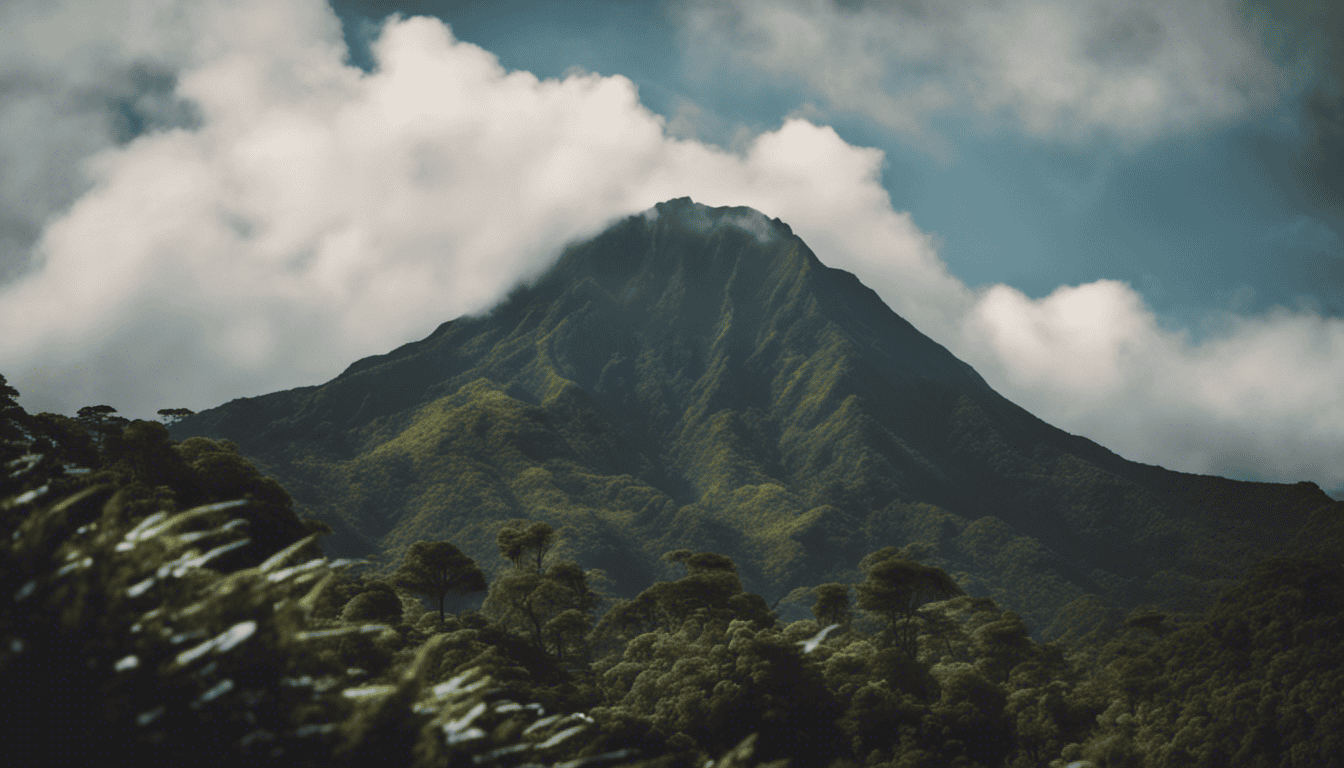
Mount Apo stands at an impressive 2,954 meters (9,692 feet) above sea level, making it the country’s tallest peak. Its grandeur extends beyond its height; it’s an important ecological and cultural landmark, often referred to as the “Grandfather of Philippine Mountains.” The name “Apo” means “master” or “grandparent” in the local indigenous languages, emphasizing its significance.
Hiking and Biodiversity
Hiking Mount Apo is a rewarding experience for nature enthusiasts and adventure seekers. The mountain is covered in lush forests that are home to a remarkable variety of plant and animal species, many of which are endemic to the Philippines. Keep your eyes peeled for the famous Philippine eagle, which calls Mount Apo home.
The most popular trail is the Kidapawan trail, which is known for its stunning landscapes, including mossy forests, rivers, and panoramic vistas. As you ascend the mountain, you’ll witness the changing flora and fauna, offering a unique experience in each altitude zone.
Hiking Preparations
Hiking Mount Apo requires careful planning and preparation. Here are some essential tips:
- Local Guide: It’s highly recommended to hire an experienced local guide who is familiar with the terrain, weather conditions, and safety measures.
- Permits: Ensure you have the necessary permits, as these are required for hiking in the Mount Apo Natural Park.
- Weather Awareness: Be aware of the weather, as conditions can change rapidly on the mountain. It’s important to plan your hike during the dry season (usually between December and May).
- Physical Preparation: This is a challenging hike, and being physically prepared will enhance your experience.
Cultural Interaction
Hiking Mount Apo also offers the opportunity to engage with local indigenous communities. Many tribes, such as the Bagobo and Manobo, call the mountain and its foothills home. You can learn about their traditions, customs, and way of life, making your journey more enriching and culturally significant.
Traveler’s Tip:
Take your time to acclimate to the higher altitudes, stay hydrated, and follow Leave No Trace principles to preserve the beauty of the mountain.
As we continue our journey through the Philippines, you’ll discover that the country is not only a land of stunning landscapes but also a sanctuary for unique flora and fauna. Our next destination is the heart of Manila, where we’ll explore the historical Rizal Park and the old-world charm of Intramuros. Join us as we uncover more of the Philippines’ history and culture.
10. Rizal Park and Intramuros, Manila
Our final stop takes us to the heart of Manila, the capital city of the Philippines, where history, culture, and the spirit of the nation come together. In this section, we’ll explore two iconic destinations – Rizal Park and Intramuros, which offer a glimpse into the rich tapestry of the Philippines.
Rizal Park: A National Symbol
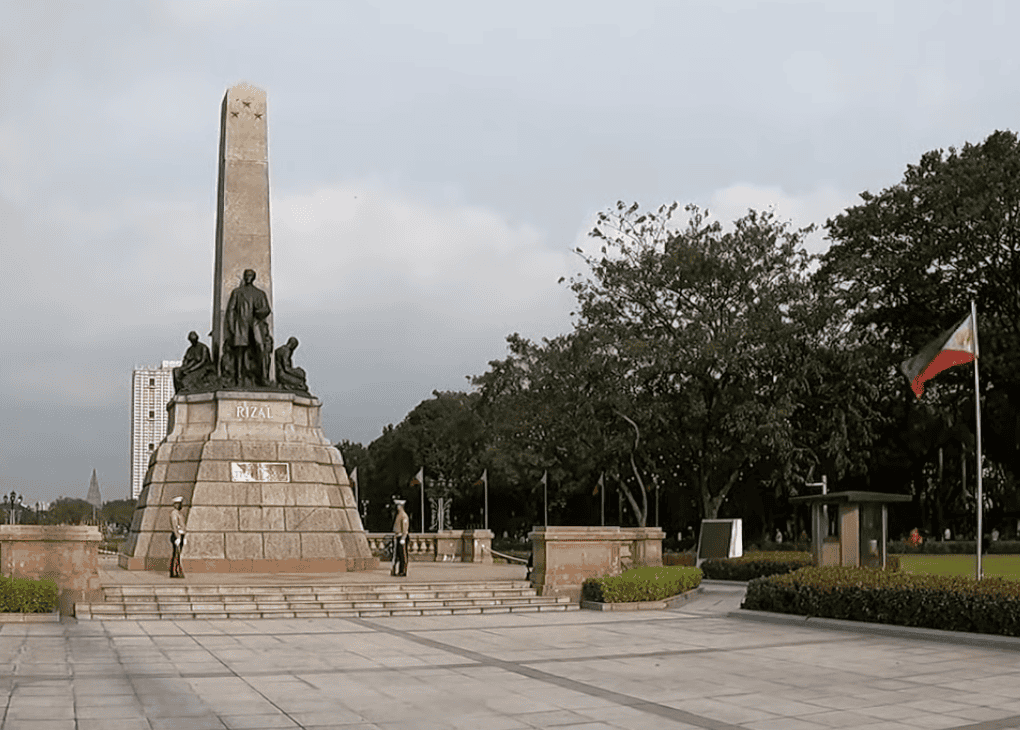
Rizal Park, also known as Luneta Park, is a significant historical and cultural landmark in Manila. Named in honor of Dr. Jose Rizal, the national hero of the Philippines, the park stands as a testament to the nation’s struggle for independence and the sacrifices made by its people.
At the heart of the park is the Rizal Monument, an imposing sculpture of Dr. Jose Rizal, who played a pivotal role in the country’s fight for freedom from Spanish colonization. It’s a place of reflection and remembrance, where you can pay your respects to a man whose writings and ideals inspired the Philippine revolution.
Intramuros: The Old Walled City
Just a stone’s throw away from Rizal Park, Intramuros is a journey back in time to the Spanish colonial period. The name “Intramuros” means “within the walls,” and it encapsulates the historical heart of Manila. Enclosed by massive stone walls, this area was the seat of Spanish power during their colonization of the Philippines.
As you explore the narrow streets and visit well-preserved buildings, you’ll gain a sense of the city’s history and the fusion of Spanish and Filipino cultures. Don’t miss key attractions within Intramuros:
- Fort Santiago: This historic fort, where Dr. Rizal was imprisoned before his execution, is a significant site for Philippine history. Explore the fort’s dungeons, plazas, and lush gardens.
- San Agustin Church: This beautifully preserved church is a UNESCO World Heritage Site and one of the oldest stone churches in the Philippines.
- Plazas and Cobblestone Streets: Stroll through the plazas and cobblestone streets to soak in the old-world charm and architectural wonders.
Cultural Events and Performances
Both Rizal Park and Intramuros often host cultural events, performances, and exhibitions that celebrate Filipino art, music, and heritage. Keep an eye out for any scheduled events during your visit, as they can enhance your experience.
Traveler’s Tip:
Visiting Rizal Park and Intramuros is most pleasant in the morning or late afternoon when the weather is milder. Wear comfortable walking shoes, as you’ll be exploring on foot.
Our journey through the Philippines’ best sightseeing places comes to a close in the heart of Manila. This country is a captivating blend of natural beauty, rich cultural heritage, and warm hospitality. Whether you’re an adventurer, a history enthusiast, or a nature lover, the Philippines offers an array of experiences that will leave a lasting impression. Thank you for joining me on this virtual tour, and I hope it inspires you to embark on your own adventures in this stunning archipelago.
As we conclude our virtual journey through the Philippines, we’ve explored a diverse and awe-inspiring array of destinations, each offering a unique blend of natural beauty, cultural richness, and historical significance. The Philippines, with its 7,000 islands, is a treasure trove of experiences waiting to be discovered.
From the magnificent terraces of Banaue to the mystical depths of the Puerto Princesa Underground River, from the heights of Mount Apo to the cobblestone streets of Vigan, we’ve ventured through a country that’s not only defined by its stunning landscapes but also by its resilient spirit and vibrant culture.
This blog post has aimed to provide you with a comprehensive guide to the 10 best sightseeing places in the Philippines, drawing upon a wealth of knowledge and insights from decades of experience as a tourism guide. We’ve navigated through mountains, underwater realms, and historical sites, all while emphasizing the importance of responsible tourism.
The Philippines, with its natural wonders and rich cultural heritage, offers a diverse range of experiences that cater to every type of traveler. Whether you seek adventure, history, or simply a chance to unwind on beautiful beaches, this archipelago has it all.
As you plan your journey to the Philippines, remember to check for the latest travel advisories, local regulations, and safety precautions. Respect local customs and traditions, and engage with the communities you encounter along the way.
The Philippines is a destination that has captivated the hearts of travelers for generations, and we hope that it will do the same for you. From the towering peaks to the hidden coves, from the historical landmarks to the pristine reefs, this country offers a world of wonder for you to explore.
So, pack your bags, prepare for adventure, and get ready to embark on your very own journey through the 7,000 islands of the Philippines, where the next sightseeing marvel is waiting just around the corner.
Additional Tips for Your Philippine Adventure
Traveling to the Philippines is an exciting and memorable experience, but like any journey, it’s important to be well-prepared. Here are some additional tips to help ensure a smooth and enjoyable adventure:
1. Respect the Local Culture and Customs:
- Filipinos are known for their warm hospitality. Be polite, greet people with a smile, and engage respectfully with the local culture. Learning a few basic phrases in Filipino (Tagalog) can go a long way in building connections with locals.
2. Weather and Packing:
- The Philippines has a tropical climate, so pack lightweight and breathable clothing. Don’t forget swimwear and sunscreen for beach destinations.
- Be prepared for sudden rain, especially during the rainy season (June to November). A light rain jacket or umbrella can be handy.
3. Travel Insurance:
- It’s advisable to have comprehensive travel insurance that covers medical emergencies, trip cancellations, and lost luggage. Check the coverage details before your trip.
4. Currency and Payments:
- The currency is the Philippine Peso (PHP). Credit cards are widely accepted in urban areas, but it’s a good idea to carry some cash, especially in rural locations.
5. Local Transportation:
- Public transportation varies by region. In major cities, you’ll find taxis, buses, and tricycles. In rural areas, transportation can be more limited. Research the options and, if needed, arrange transportation in advance.
6. Language:
- English is widely spoken and understood, especially in tourist areas. Learning a few basic Tagalog phrases can be helpful.
7. Safety Precautions:
- While the Philippines is generally a safe destination, it’s essential to take common-sense safety precautions. Keep an eye on your belongings and be cautious in crowded areas.
- Stay informed about the latest travel advisories for specific regions and areas you plan to visit.
8. Health and Vaccinations:
- Consult your doctor or a travel clinic for recommended vaccinations before your trip. It’s essential to stay hydrated, especially in hot and humid areas.
9. Local Cuisine:
- Filipino cuisine offers a wide variety of dishes, and trying local food is a must. Be adventurous, but also cautious with street food to avoid any stomach discomfort. Stick to bottled water and peeled fruits if you’re concerned about hygiene.
10. Responsible Tourism:
- Be mindful of your impact on the environment and local communities. Follow the principles of “Leave No Trace” when exploring natural areas and support sustainable tourism practices.
11. Emergency Contact Information:
- Keep a list of important phone numbers, including the contact details of your country’s embassy or consulate in the Philippines, handy in case of emergencies.
Exploring the Philippines offers a world of possibilities, from pristine beaches and lush rainforests to vibrant city life and rich cultural experiences. With the right preparations and a spirit of adventure, your trip to this stunning archipelago is sure to be a memorable and enriching journey.
Frequently Asked Questions (FAQ)
This section to provide further guidance and answers to common queries about traveling to the Philippines:
Q1: Do I need a visa to visit the Philippines?
- Most tourists from many countries are granted visa-free entry for a period of 30 days, which can be extended for an additional 29 days. Check with the Philippine embassy or consulate in your home country to verify visa requirements.
Q2: When is the best time to visit the Philippines?
- The dry season, from November to April, is generally the best time to visit as the weather is more predictable. However, the Philippines can be enjoyed year-round, with certain destinations being ideal during different seasons.
Q3: Is it safe to travel to the Philippines?
- While the Philippines is generally a safe travel destination, like any other place, it’s important to exercise caution. Be mindful of your belongings, follow local guidelines, and stay informed about specific regions you plan to visit. Check the latest travel advisories before your trip.
Q4: What’s the local currency, and can I use credit cards?
- The local currency is the Philippine Peso (PHP). Credit cards are widely accepted in urban areas and tourist destinations, but it’s a good idea to have some cash on hand, especially in rural locations.
Q5: Are there language barriers in the Philippines?
- English is widely spoken and understood, especially in tourist areas. Filipino (Tagalog) is the official language, but you’ll find a variety of regional languages and dialects across the archipelago.
Q6: What vaccinations do I need before traveling to the Philippines?
- It’s advisable to visit a travel clinic or consult your doctor for recommended vaccinations. This may include routine vaccines, as well as vaccines for diseases like Hepatitis A and Typhoid, depending on your travel plans.
Q7: Can I drink the tap water in the Philippines?
- While tap water in some urban areas is considered safe to drink, it’s generally recommended to stick to bottled water, especially in rural and remote regions.
Q8: What are some must-try Filipino dishes and street food?
- Filipino cuisine is diverse and delicious. Don’t miss trying dishes like adobo, sinigang, lechon, and local delicacies such as halo-halo, balut, and street food like barbecue, isaw, and fish balls.
Q9: How can I get around the Philippines?
- Transportation options include domestic flights, buses, tricycles, jeepneys, and taxis in urban areas. In more remote areas, transportation options can be limited, so research and plan your routes accordingly.
Q10: What are some responsible tourism practices I should follow in the Philippines?
- Embrace sustainable and responsible tourism by respecting the environment, local customs, and cultural traditions. Follow the principles of “Leave No Trace,” and choose eco-friendly and community-supporting tour operators.
Remember that while these FAQs provide general information, it’s essential to tailor your travel plans to your specific needs and preferences. Always stay informed, be prepared, and embrace the spirit of adventure when exploring the Philippines.

David, a spirited blog journalist, is always on the lookout for adventure and thrifty travel experiences. His mission is to share stories from the world’s most incredible destinations and the frugal individuals who call them home.
When he’s not chasing down leads or conducting interviews, David can be found exploring the world around him without emptying his wallet. He has a deep love for travel and has journeyed to some of the most far-flung corners of the globe, all while keeping an eye on his budget.
With his insatiable sense of wanderlust and his commitment to excellence without overspending, David is a valued member of our team, and we are proud to have him as part of our community.
